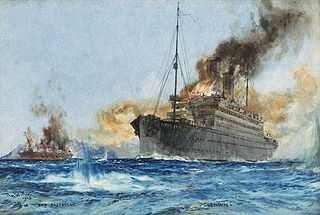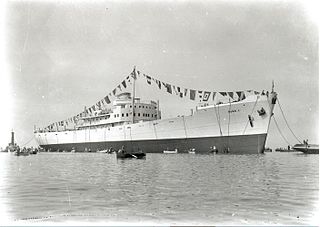The United States Navy, United States Coast Guard, and United States National Oceanic and Atmospheric Administration (NOAA) use a hull classification symbol to identify their ships by type and by individual ship within a type. The system is analogous to the pennant number system that the Royal Navy and other European and Commonwealth navies use.

A convoy is a group of vehicles, typically motor vehicles or ships, traveling together for mutual support and protection. Often, a convoy is organized with armed defensive support. It may also be used in a non-military sense, for example when driving through remote areas. Arriving at the scene of a major emergency with a well-ordered unit and intact command structure can be another motivation.

The Battle of the Atlantic, the longest continuous military campaign in World War II, ran from 1939 to the defeat of Nazi Germany in 1945, covering a major part of the naval history of World War II. At its core was the Allied naval blockade of Germany, announced the day after the declaration of war, and Germany's subsequent counter-blockade. The campaign peaked from mid-1940 through to the end of 1943.

Merchant raiders are armed commerce raiding ships that disguise themselves as non-combatant merchant vessels.

An armed merchantman is a merchant ship equipped with guns, usually for defensive purposes, either by design or after the fact. In the days of sail, piracy and privateers, many merchantmen would be routinely armed, especially those engaging in long distance and high value trade.

The German auxiliary cruiser Kormoran (HSK-8) was a Kriegsmarine merchant raider of World War II. Originally the merchant vessel Steiermark ("Styria"), the ship was acquired by the navy following the outbreak of war for conversion into a raider. Administered under the designation Schiff 41, to the Allied navies she was known as "Raider G." The largest merchant raider operated by Germany during World War II, Kormoran ("cormorant") was responsible for the destruction of 10 merchant vessels and the capture of an 11th during her year-long career in the Atlantic and Indian oceans.

On September 3, 1939, the British and French declarations of war on Germany initiated the Battle of the Atlantic. The United States Navy Chief of Naval Operations (CNO) established a combined air and ship patrol of the United States Atlantic coast, including the Caribbean, on September 4. President Franklin D. Roosevelt declared the United States' neutrality on September 5, and declared the naval patrol a Neutrality Patrol. Roosevelt's initiation of the Neutrality Patrol, which in fact also escorted British ships, as well as orders to U.S. Navy destroyers first to actively report U-boats, then "shoot on sight", meant American neutrality was honored more in the breach than observance.

Commerce raiding is a form of naval warfare used to destroy or disrupt logistics of the enemy on the open sea by attacking its merchant shipping, rather than engaging its combatants or enforcing a blockade against them.

HMAS Sydney, named after the Australian city of Sydney, was one of three modified Leander-class light cruisers operated by the Royal Australian Navy (RAN). Ordered for the Royal Navy as HMS Phaeton, the cruiser was purchased by the Australian government and renamed prior to her 1934 launch.

The Romanian Navy is the navy branch of the Romanian Armed Forces; it operates in the Black Sea and on the Danube. It traces its history back to 1860.

The Battle of the Mediterranean was the name given to the naval campaign fought in the Mediterranean Sea during World War II, from 10 June 1940 to 2 May 1945.

The Japanese raiders in the Indian Ocean were those vessels used by the Imperial Japanese Navy during the Second World War to pursue its war on Allied commerce in that theatre. Possessing a powerful fleet of warships, prior to the start of World War II, the Imperial Japanese Navy (IJN) had strategically planned to fight a war of fleet actions, and as a consequence delegated few resources to raiding merchant vessels. Nevertheless, in 1940, two passenger-cargo vessels – Aikoku Maru and Hōkoku Maru – of the Osaka Shipping Line were requisitioned for conversion to Armed Merchant Cruisers (AMC)s, in anticipation of the likely thrust southward by the Japanese. These vessels were subsequently used as merchant raiders attacking Allied commercial shipping along vital sea lanes of communication between Australia and the Middle East. Using their comprehensive armament and speed to their advantage, the raiders experienced a brief period of success. Japanese raiding in the Indian Ocean largely ceased by the end of 1942 after an action with a Dutch vessel, the Ondina and a Royal Indian Navy corvette, the Bengal in which the Hokoku Maru was sunk.

Asian and Pacific theatre of World War I consisted of various military engagements that took place on the Asian continent and on Pacific islands. They include naval battles, the Allied conquest of German colonial possessions in the Pacific Ocean and China, and an anti-Russian rebellion in Russian Turkestan. The most significant military action was the careful and well-executed Siege of Tsingtao in China, but smaller actions were also fought at Bita Paka and Toma in German New Guinea.

The Italian ship Ramb I was a pre-war "banana boat" converted to an auxiliary cruiser during World War II. Ramb I operated as an armed merchant in the Red Sea and was ordered to sail to Japan after the fall of Massawa to the Allies. She was sunk in the Indian Ocean before she could reach her intended destination.

The U-boat Campaign from 1914 to 1918 was the World War I naval campaign fought by German U-boats against the trade routes of the Allies. It took place largely in the seas around the British Isles and in the Mediterranean. The German Empire relied on imports for food and domestic food production and the United Kingdom relied heavily on imports to feed its population, and both required raw materials to supply their war industry; the powers aimed, therefore, to blockade one another. The British had the Royal Navy which was superior in numbers and could operate on most of the world's oceans because of the British Empire, whereas the Imperial German Navy surface fleet was mainly restricted to the German Bight, and used commerce raiders and unrestricted submarine warfare to operate elsewhere.

SM U-21 was a U-boat built for the Imperial German Navy shortly before World War I. The third of four Type U-19-class submarines, these were the first U-boats in German service to be equipped with diesel engines. U-21 was built between 1910 and October 1913 at the Kaiserliche Werft in Danzig. She was armed with four torpedo tubes and a single deck gun; a second gun was added during her career.

The action of 29 February 1916 was a naval engagement fought during the First World War between the United Kingdom and the German Empire. SMS Greif, a German commerce raider, broke out into the North Sea and Admiral Sir John Jellicoe dispatched Royal Navy warships to intercept the raider. Four British vessels intercepted the commerce raider Greif. The armed merchant cruiser RMS Alcantara and Greif fought a brief engagement before British reinforcements arrived when both were severely damaged, both being sunk.
Convoys SL 139/MKS 30 were two Allied convoys which ran during the Battle of the Atlantic in World War II. SL 139 was one of the SL convoys from the South Atlantic to Britain, and MKS 30 one of the MKS convoys between Britain and the Mediterranean. They were sailing together on the Gibraltar homeward route, having made a rendezvous off Gibraltar in November 1943. They were the subject of a major U-boat attack, as part of the Kriegsmarine's renewed Autumn offensive.
In the beginning of World War II the Royal Navy was the strongest navy in the world, with the largest number of warships built and with naval bases across the globe. Totalling over 15 battleships and battlecruisers, 7 aircraft carriers, 66 cruisers, 164 destroyers and 66 submarines. With a massive merchant navy, about a third of the world total, it also dominated shipping. The Royal Navy fought in every theatre from the Atlantic, Mediterranean, freezing Northern routes to Russia and the Pacific ocean.
Naval historians such as Evan Mawdsley, Richard Overy, and Craig Symonds concluded that World War II's decisive victories on land could not have been won without decisive victories at sea. Naval battles to keep shipping lanes open for combatant's movement of troops, guns, ammunition, tanks, warships, aircraft, raw materials, and food largely determined the outcome of land battles. Without the Allied victory in keeping shipping lanes open during the Battle of the Atlantic, Britain could not have fed her people or withstood Axis offensives in Europe and North Africa. Without Britain's survival and without Allied shipments of food and industrial equipment to the Soviet Union, her military and economic power would likely not have rebounded in time for Russian soldiers to prevail at Stalingrad and Kursk.















